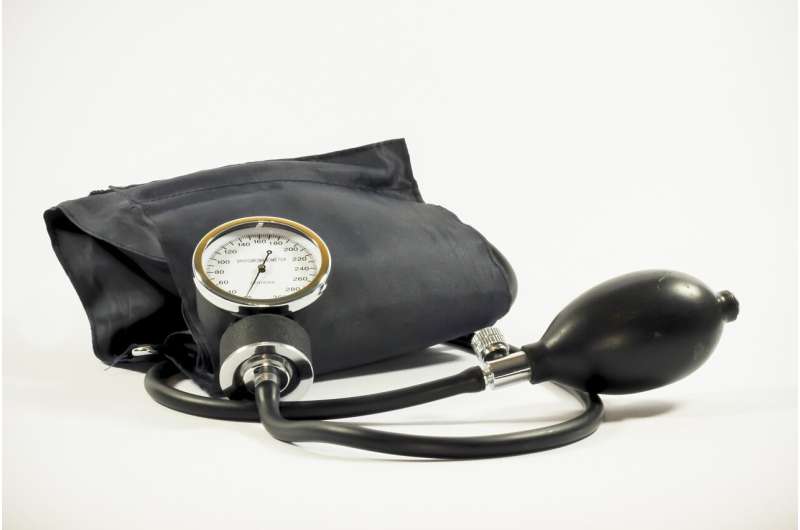This article has been reviewed according to Science X's editorial process and policies. Editors have highlighted the following attributes while ensuring the content's credibility:
fact-checked
trusted source
proofread
High blood pressure is the most deadly risk factor for women worldwide

All women should know their blood pressure to prevent heart disease and stroke, urged cardiologists from the European Society of Cardiology (ESC) on World Hypertension Day.
"Cardiovascular disease is the leading cause of death in women," said ESC spokesperson Professor Angela Maas, emeritus director of the Women's Cardiac Health Programme, Radboud University Medical Centre, Nijmegen, the Netherlands. "The risk for cardiovascular disease increases at a lower blood pressure level in women compared to men. My message to all women is to take your blood pressure seriously, know your values and convince your doctor that if it is too high then you need treatment. Don't underestimate the long-term effects of high blood pressure."
"One of the most important consequences of hypertension in women is a type of heart failure in which the heart muscle is stiff," she continued. "There are few treatments for that condition, so if you want to avoid symptoms such as shortness of breath, fatigue and fluid retention when you are over 70, you have to start treating high blood pressure in middle age. If you wait 20 years, it is too late."
Around one in three women have hypertension globally. Raised blood pressure has been named the most important risk factor for death in women across the world. "Despite its importance, we know that hypertension is more often underestimated and not, or insufficiently, treated in women compared to men," said Professor Maas. "One of the reasons may be that below the age of 50, hypertension is more prevalent in men. This reverses in the years after menopause so that after the age of 65, hypertension is more common in women than men."
It is a misconception that high blood pressure does not cause symptoms. In fact, symptoms are more pronounced in women but may be mistaken for menopause, anxiety or stress. Young and middle-aged women with high blood pressure often report palpitations, chest pain, pain between the shoulder blades, headaches, difficulty concentrating, shortness of breath, tiredness, fluid retention, poor sleep, hot flushes and a feeling that their bra is too tight.
"When we treat hypertension, many symptoms erroneously attributed to menopause disappear," said Professor Maas. "Night sweats can be caused by high blood pressure, for example, so women with menopausal symptoms should have their blood pressure checked and treated if needed."
Hypertension in midlife is more harmful in women than in similarly aged men, and is a stronger risk factor for myocardial infarction, cognitive decline and dementia.2 The probability of stroke increases at a lower blood pressure level in women than in men, while high blood pressure raises the risk for heart failure in women by three-fold, compared to two-fold in men.
Professor Maas said, "Hypertension is currently defined as a systolic blood pressure of at least 140 mmHg and/or diastolic blood pressure of 90 mmHg or higher.3 But discussions are underway about whether normal blood pressure values should be lower in women compared to men. More research is needed before there is any change in treatment guidelines but I expect that within five years the threshold for normal blood pressure will be lower in women than men."
Certain life events predispose women to developing hypertension such as having migraines from their teenage years, having two or more miscarriages, hypertension during pregnancy (which affects around one in seven pregnant women) and preeclampsia (a more severe form of hypertension during pregnancy). "Women have more of those specific life events than men," said Professor Maas. "Physicians can use these clues to identify middle aged women at higher risk of hypertension and to signal that blood pressure monitoring needs to be taken more seriously."
Know your blood pressure: measure it at home. Professor Maas said, "I always advise my female patients to share a blood pressure device with their sisters, neighbours or friends and measure it themselves. When we asked women with preeclampsia to check their blood pressure at home, approximately one in four had hypertension that would have been missed with usual care."
When should you start measuring blood pressure and how often? Start yearly monitoring at age 40 if you have hypertension in your family or you had hypertension during pregnancy. Women with preeclampsia should check their blood pressure from that pregnancy onwards at least twice a year. Women with no issues during pregnancy and no family history should start yearly measurement at age 50 when they enter menopause.
How high is too high? A diagnosis of hypertension is not established from one measurement. Women under 80 years of age should see their doctor for further investigation if their systolic blood pressure is 130 mmHg or higher, while for those 80 years or older a value of 150 mmHg should trigger a visit to the doctor.
Professor Maas said, "A healthy lifestyle is also important to prevent or treat high blood pressure. That means regular exercise, a nutritious diet, reducing salt intake, smoking cessation, losing excess weight and limiting alcohol consumption."


















